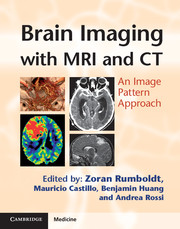Book contents
- Frontmatter
- Contents
- List of contributors
- List of abbreviations
- Preface
- Section 1 Bilateral Predominantly Symmetric Abnormalities
- Section 2 Sellar, Perisellar and Midline Lesions
- Section 3 Parenchymal Defects or Abnormal Volume
- Section 4 Abnormalities Without Significant Mass Effect
- Section 5 Primarily Extra-Axial Focal Space-Occupying Lesions
- Section 6 Primarily Intra-Axial Masses
- Section 7 Intracranial Calcifications
- 184 Congenital Cytomegalovirus Infection
- 185 Congenital Toxoplasmosis
- 186 Aicardi–Goutieres Syndrome
- 187 Physiologic Basal Ganglia Calcifications
- 188 Hyperparathyroidism
- 189 Meningioangiomatosis
- 190 Vascular Wall Calcification
- 191 Dystrophic Calcifications
- 192 Calcified Aneurysms
- 193 Vascular Malformations
- 194 Cysticercosis
- 195 Calcified Metastases
- 196 Ganglioglioma
- 197 Oligodendroglioma
- 198 Cortical Tubers in Tuberous Sclerosis
- 199 Subependymal Nodules in Tuberous Sclerosis
- 200 Ependymoma
- 201 Lipoma With Calcification
- 202 Craniopharyngioma
- 203 Meningioma
- 204 Teflon Granuloma
- Index
- References
190 - Vascular Wall Calcification
from Section 7 - Intracranial Calcifications
Published online by Cambridge University Press: 05 August 2013
- Frontmatter
- Contents
- List of contributors
- List of abbreviations
- Preface
- Section 1 Bilateral Predominantly Symmetric Abnormalities
- Section 2 Sellar, Perisellar and Midline Lesions
- Section 3 Parenchymal Defects or Abnormal Volume
- Section 4 Abnormalities Without Significant Mass Effect
- Section 5 Primarily Extra-Axial Focal Space-Occupying Lesions
- Section 6 Primarily Intra-Axial Masses
- Section 7 Intracranial Calcifications
- 184 Congenital Cytomegalovirus Infection
- 185 Congenital Toxoplasmosis
- 186 Aicardi–Goutieres Syndrome
- 187 Physiologic Basal Ganglia Calcifications
- 188 Hyperparathyroidism
- 189 Meningioangiomatosis
- 190 Vascular Wall Calcification
- 191 Dystrophic Calcifications
- 192 Calcified Aneurysms
- 193 Vascular Malformations
- 194 Cysticercosis
- 195 Calcified Metastases
- 196 Ganglioglioma
- 197 Oligodendroglioma
- 198 Cortical Tubers in Tuberous Sclerosis
- 199 Subependymal Nodules in Tuberous Sclerosis
- 200 Ependymoma
- 201 Lipoma With Calcification
- 202 Craniopharyngioma
- 203 Meningioma
- 204 Teflon Granuloma
- Index
- References
Summary
Specific Imaging Findings
Wall calcifications are most commonly seen on unenhanced CT along the internal carotid arteries (carotid siphon), the vertebral arteries, middle cerebral arteries, and basilar artery. They range from fine and barely perceptible to chunky ones, several millimeters in thickness. When viewed in cross-section, mural calcifications appear ring-like, curvilinear, or stippled; when the affected artery is viewed longitudinally, they appear tubular, stippled and discontinuous, or plaque-like. Associated luminal narrowing may or may not be present. They are difficult to see on routine MRI, but very thick ones appear as a hypointense vessel rim.
Pertinent Clinical Information
Intracranial arterial calcifications are extremely common and often incidental on head CT, but are exceedingly uncommon under the age of 20. Their prevalence is roughly 50% at 41–60 and 90% at 61–80 years of age. In younger patients they may indicate an underlying metabolic disorder.
Differential Diagnosis
Calcified Aneurysms (144, 192)
• affected segment is dilated
• confirmed with CTA or MRA
• atherosclerotic calcifications can be mistaken for small aneurysms on CTA but distinguished with unenhanced CT
Dense Vessel Sign in Early Infarction (111)
• the vessel is mildly hyperdense, not calcified
• may coexist
Calcified Vascular Malformations (182, 183, 193)
• patchy calcifications common in cavernomas and AVMs
• typically peripherally located
Information
- Type
- Chapter
- Information
- Brain Imaging with MRI and CTAn Image Pattern Approach, pp. 393 - 394Publisher: Cambridge University PressPrint publication year: 2012
